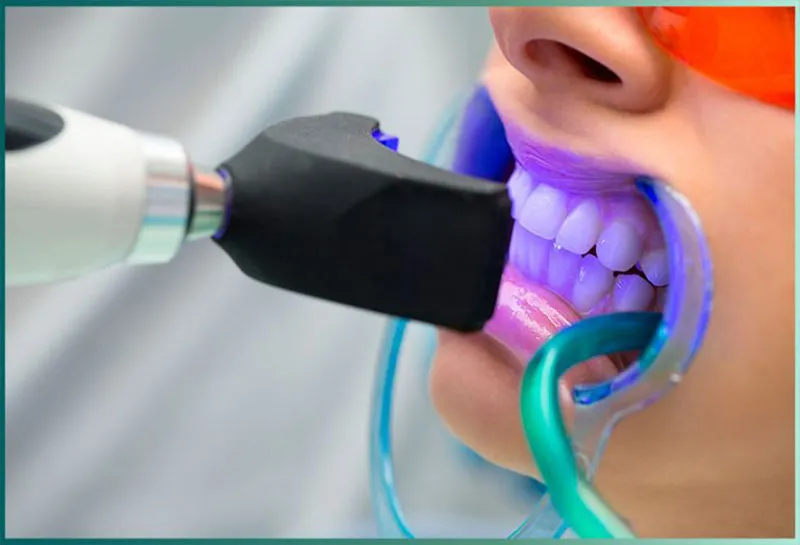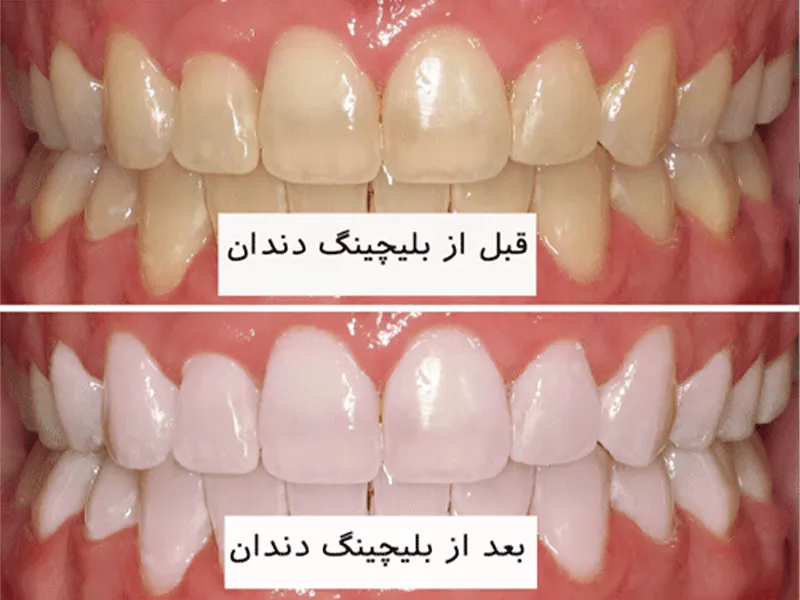In this article, we would like to talk to you about teeth bleaching and the advantages and disadvantages of that tooth, prohibitions of tooth bleaching, etc. So, to get more information about teeth bleaching , follow us until the end of the article from Mehr Shariati Dental Clinic .
Durability of teeth bleaching
It may depend on a number of factors, including the type of bleaching used, the initial condition of the teeth, personal habits (such as smoking or foods suspected of staining) and post-bleaching care.
Typically, teeth bleaching usually provides good results in a short period of time, but these results may fade over time. To solve this problem, you may need to repeat bleaching or you may be suggested to use maintenance products after bleaching.
How is bleaching done?
Teeth bleaching is a procedure used to reduce stains and discoloration of teeth and is usually performed by dentists. The methods of teeth bleaching are:
-
Internal Bleaching:
In this method, the dentist applies a strong bleaching gel along with hydrogen peroxide or carbamide peroxide inside the required tooth and then protects the tooth with a plastic band. This process is usually repeated several times to achieve the desired results.
-
External Bleaching (External Bleaching):
In this method, special bleaching materials (gel, tape, or other special decorations) are used, which are placed on the surface of the teeth. Usually these products contain hydrogen peroxide or carbamide peroxide. This method can be easily done at home with the guidance of a dentist or available educational products.
How many degrees does bleaching lighten teeth?
The degree of effectiveness of teeth bleaching on the color of teeth depends on various factors, including the type of bleaching product, the health of the teeth, the initial state of the color of the teeth, and behavioral factors such as smoking and the type of substances consumed that may lead to staining.
In general, bleaching can lighten teeth by a few degrees, but the final results depend on each person and their personal circumstances. Some people see noticeable results in one or two bleaching sessions, while others may need to repeat bleaching to achieve the desired result.

Comparison of bleaching and composite
Bleaching and composite are two different methods in the field of improving the appearance of teeth and increasing their brightness.
-
Teeth bleaching:
– Purpose: Teeth bleaching is used to reduce stains and color changes of the teeth and increases the natural brightness of the teeth.
– Implementation method: it may be done internally (by placing bleaching gel inside the tooth) or externally (using bleaching products on the surface of the tooth).
– Result: Bleaching can make the teeth brighter naturally and in a certain color range, but the final result depends on the initial condition of the teeth and the type of bleaching used.
-
Dental composite:
Purpose: Dental composite is a coating method used to fix the appearance of teeth defects such as cracks, stains, crevices, wrinkles and even increasing the size of teeth.
– Implementation method: Composite is glued as a plastic colored material on the surface of the tooth and is shaped using special techniques such as layering and sanding.
– Result: The composite is placed directly on the teeth and can significantly improve the appearance defects and make the color of the teeth more harmonious.
The comparison between bleaching and composite depends on your needs and problems. If you need to increase the natural brightness of your teeth and reduce stains, bleaching is suitable. If you need to repair the appearance of teeth defects or change the shape and size of teeth, composite is the best option. Find the best solution by consulting your dentist.
Comparison of bleaching and scaling
Comparing teeth bleaching and scaling depends on your goals and needs. These two methods are used for different purposes in the field of teeth improvement and hygiene.
Teeth bleaching:
– Purpose: Teeth bleaching is used to improve the appearance of teeth and increase their natural brightness. This method is usually used to reduce stains and discoloration of the teeth.
– Implementation method: Teeth bleaching can be done internally (by placing bleaching gel inside the tooth) or externally (using bleaching products on the surface of the tooth).
– Result: Bleaching can make the teeth brighter naturally and in a certain color range.
Dental scaling:
– Purpose: Tooth scaling is used to clean teeth by removing deposits, plaque, and surface stains of teeth and helps oral hygiene.
– Implementation method: Teeth scaling is done by a dentist or by scaling components usually with sonic, electric or manual.
– Result: Tooth scaling can clean the teeth from deposits and plaque and reduce the possibility of gum and teeth diseases.
Bleaching composite teeth
If your teeth are composited (i.e. veneered using composite materials), teeth bleaching can help you increase the brightness and color harmony of your composite teeth. But it should be noted that bleaching on composite teeth should be done with caution and requires special maintenance.
The composite materials used on the teeth usually have fixed colors, and great care is taken in choosing the color to match the color of the surrounding teeth. Bleaching of composite teeth may affect the color of surrounding teeth or even reduce the color of composites. Therefore, for the bleaching of composite teeth, it is better to consult an expert dentist in this field.
Complications of teeth bleaching
Bleaching is a generally safe cosmetic procedure, but some people may be allergic to it or have side effects. Some of its complications include:
- Tooth sensitivity: This is one of the most common side effects of bleaching and teeth may become sensitive to cold or heat. This sensitivity is usually related to the bleaching materials used and occurs mostly in the first few days after bleaching.
- Irritation of gums and oral tissues: Bleaching may cause irritation and inflammation of the gums and oral tissues, causing them to swell and bleed.
- Damage to tooth enamel: Excessive use of bleaching can lead to damage to tooth enamel and cause more sensitivity.
- Inadequate or uneven results: Bleaching results may not be the same for everyone, and in some cases, teeth may lighten unevenly.
- Temporary effects: After bleaching, the color of the teeth may change temporarily, and some people may return to the previous color after a while.
Number of bleaching sessions
The number of teeth bleaching sessions depends on the type of bleaching used, the amount of teeth discoloration and the initial condition of the teeth. Teeth bleaching is usually done in several sessions, but the exact number of sessions may vary.
- Professional bleaching: This type of bleaching is performed by dentists in the clinic and is usually repeated in several sessions, usually 2 to 4 sessions are enough to improve the color of the teeth.
- Home bleaching: This type of bleaching is usually done by the person at home using bleaching kits. These kits include customized bleaching gel and teeth enhancers. The duration and number of home bleaching sessions usually varies from person to person and may last for several weeks.

Benefits of teeth bleaching
Teeth bleaching is one of the common methods of beautifying the teeth, which is used to reduce stains and color changes of the teeth.
- Brighten teeth: Bleaching can help make your teeth look brighter and more sun-kissed.
- Improved appearance and self-confidence: By reducing the stains and color changes of the teeth, the appearance of the teeth is improved and people usually feel more confident in social relationships.
- Simpler and non-invasive: Bleaching is a non-invasive method, in the sense that there is no need to buy dentures or restore the teeth, and only by using bleaching materials can the teeth be brought to the desired brightness.
- Fast results: Usually, the results of bleaching appear quickly and you can achieve the desired results in a few sessions.
- Reproducibility: teeth bleaching can be done if needed to repeat the process of improving the color of the teeth.
Baby teeth bleaching
Bleaching is not recommended for children under a certain age (usually under 16). This is because children’s teeth are still growing and developing and allow them to mature naturally. The reasons why teeth bleaching is not recommended in children up to a certain age are:
- Tooth sensitivity: Children’s teeth may be more sensitive than older teeth, and bleaching may increase this sensitivity.
- Risk of enamel damage: Bleaching may damage the enamel of developing teeth and cause future problems.
- Impact on teeth development: Bleaching may affect the growth and development of children’s teeth and affect their normal function.
Conclusion
It is important to continue taking care of your teeth and using protective products such as toothpaste and oral antibacterial concentrates in an appropriate amount to prevent the return of stains and color changes. However, it is best to get more specific suggestions and guidance from your dentist.

